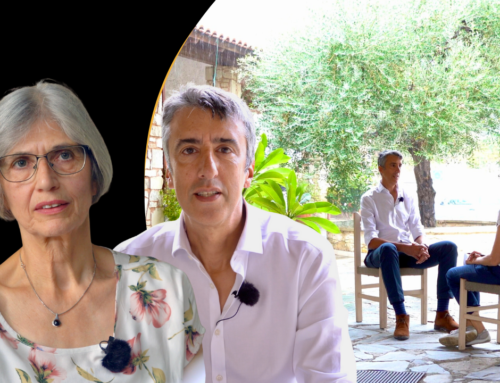In mid-May 18 participants from Bulgaria, Estonia, Finland, Greece, Hungary, Lithuania, Portugal, Slovenia, and Switzerland come to Latvia to participate in the cross-visit organized by the Latvian Rural Advisory and Training Centre (LRATC). What does cross-visit mean exactly, and how does it differ from an exchange of experiences? Of course, participants in this case also share their experiences and engage in active discussions however, the idea of a cross-visit is that during this visit, participants reinforce the knowledge they acquired during their training about interactive innovation methods. This means that while visiting various projects, participants put their heads together to think about interesting solutions to existing challenges within presented initiatives.
The host, LRATC is the biggest rural advisory organization in Latvia that provides support, guidance, and training to farmers, rural entrepreneurs, and other individuals involved in rural development in Latvia. At the moment LRATC employs around 430 employees who work all across the country in 26 branch offices and in the central office which is located in Ozolnieki. And now shortly about Latvian agriculture.
CROPS
The main agricultural crops grown in Latvia include grains such as wheat, barley, oats, and rye. Other important crops include potatoes, rapeseed, and various vegetables. Latvia is also known for its high-quality organic farming and the production of organic crops.
LIVESTOCK
Livestock farming is an essential component of Latvia’s agricultural sector. Dairy farming is particularly prominent, with Latvian dairy products being well-regarded. Other livestock raised in the country include pigs, poultry, sheep, and cattle.
RURAL DEVELOPMENT
The Latvian government places importance on rural development, aiming to support sustainable agriculture, improve infrastructure, and promote innovation in the sector. Funding programs and subsidies are available to support farmers, enhance productivity, and protect the environment.
AGRICULTURAL CHALLENGES
Like many countries, Latvia faces various challenges in its agricultural sector. These challenges include the aging farm population (the average age of a farmer is 57 years), farm consolidation, labor shortages (7.2 % of the labor force is working in agriculture), climate change impacts, and adapting to EU regulations and market demands.
During the cross-visit in Latvia, four cases vere visited and analyzed in depth by using i2connect methods:
- PATATOE-BASED INNOVATIVE COMPONENT DEVELOPMENT AND PRODUCTION FOR PASTRY (CAKES)
The aim of the project was to create new foods and new recipes using specific varieties of potatoes. Thus creating a new outlet for a common agricultural product – the potato. The need for new products (cakes) – a healthier product could promote public health and the diversification of confectionery products in accordance with new market trends and the needs
of society. The project shows that it is possible to get an even wider application from a classic product, which is used in very simple ways, meanwhile expanding the market for the product of primary production as well.
The host, Linda Šarķe-Fedjajeva, LRATC: “Several potato varieties have been tested within the project, and more than 70 cake recipes have been created with potatoes as the main ingredient! Host Juris Goldmanis had brought along two potato cakes – chocolate/orange and cranberry. The idea of creating cakes using potatoes arose from the desire to replace the use of dairy products in production, as the consumer base with gluten, lactose, and various dietary and lifestyle restrictions is growing. However, it should be kept in mind that just because a product is vegan or gluten-free, or lactose-free doesn’t mean it’s not suitable for people who can eat everything! That’s not the case! I must admit that the cranberry potato cake was my favorite. Currently, the biggest challenge for the host is to conquer the market with their innovative product. Juris mentioned that “Inese’s Cakes” potato cakes can already be purchased at Stockmann and major Rimi stores. He hopes that soon the cakes will also conquer neighboring markets where the vegan lifestyle is more popular than here. The group of participants at the event conducted a network analysis to identify missing and potential collaboration channels and ways to promote the product in the market. It must be said that a true saying is – one person cannot do everything! We wouldn’t be discussing this project if it didn’t involve a farmer who grew potatoes, scientists and advisors who worked on selecting the most suitable potato varieties and developing recipes that are not only tasty but also suitable for commercialization.“ - NEW TECHNOLOGIES AND ECONOMICALLY VIABLE SOLUTIONS FOR PRODUCING LOCAL FEED FOR PIG PRODUCTION: CULTIVATION OF NON-GENETICALLY MODIFIED SOYBEANS AND NEW BARLEY VARIETIES IN LATVIA
Soybean meal is a superior source of protein in compound feeds due to its high protein contents and amino acid composition, but the EU is vastly dependent on the import of plant proteins, with the imports of soya for feed dominating. Latvia also imports considerable quantities of soybean meal that is close to the total production of local protein plants. Owing to potential economic benefits for farmers and producers of animal feed, as well as a range of environmental and climate advantages, there is political support for the development of the growing of protein crops in the EU (EU-plant protein plan, etc.).
At the same time, the development of the local supply chain of soya largely depends on the competitiveness of Latvian-grown soya. So, this was the main challenge of the project initiator – to test if it is possible grow and to harvest enough good quality soybean to shorten existing supply chains and use local products in animal feed production. Since soybean growing in Latvia is not common and there is a lack of information regarding the most suitable soybean varieties, the project seemed to be a safe environment to boost knowledge about the soybean growing constraints and possibilities. The project though is not only about the growing of soybean for feed but also test new barley varieties which could be used in feed production. The initiator – a farmer from southern part of Latvia who owns a pig farm, came up with the idea to start growing soybeans on his farm. He wanted to grow his own soybeans and produce feed for the pigs to shorten the supply chain and reduce dependence on changing soybean market prices. As he was already using mainly soybean protein in pig feed at his farm and knowing that soybean protein is difficult to replace with other protein plants, he saw great potential in developing this idea in the project application. After approaching his advisor, the project idea started to grow in the project application. Advisor used his cooperation network and attracted more enthusiasts to be involved in the project.
The host, Linda Šarķe-Fedjajeva, LRATC: “ZS Rubuļi along with 13 other collaboration partners was searching for the best soybean variety within the framework of the EIP project, with a protein content no less than those imported. ZS Rubuļi grows pigs and six different crops on their farm, which spans around 1000 hectares in Saldus municipality. After a conversation with the owner, Sergejs, and agronomist Aigars, it is clear that Sergejs is the most determined and enthusiastic of the two. This is a wonderful example of a farmer-driven initiative, where the owner openly acknowledges that the results of the farmers in the project group vary – some have been more successful, others less so. Some continue with experiments, while others have given up. Sergejs himself continues to grow soybeans at Rubuļi even after the project ends, and he claims that the soybeans sown and harvested are capable of feeding the entire pig population on the farm. It should be noted that Sergejs is able to carry out the entire soybean processing cycle, from drying to the production of ready-made animal feed, on the farm. I was surprised to learn that soybean oil contains valuable nutrients and can be used in food. I and the other cross-visit participants will be rooting for the Rubuļi family in their experiments! Keep up the great work!“ - CLIMATE-RESPONSIBLE AGRICULTURE FOR LATVIA
Soils are the largest terrestrial carbon storages on Earth. However, land-use conversion and soil cultivation over time have destroyed soil carbon stock capacity and are responsible for approximately 33% of present GHG emissions. Currently, agricultural soils account for half of the sector’s total GHG emissions in the EU, while CO2 will be responsible for 50% of the global warming experienced over the next 50 years. The majority of CO2 from agricultural lands is released through soil erosion and respiration. Globally agriculture’s share of GDP is falling, while in Latvia it increased from 3% in 2008 to 5% in 2013. Furthermore, Latvia’s agricultural GHG emissions have grown by 20% from 1999 to 2012 (from 1931.11 to 2420.30 Gg CO2 eq.) Thus, it is crucial to promote climate-responsible agricultural practices. One of the practices LRATC is involved in is the no-till technique. The main effort from the LRATC side was to set up a group of farmers who would be ready to test no-till and provide whatever advisory support the farmer group of interest would need. No-till farming is a way of growing crops without disturbing the soil through tillage. The no-till technique increases organic matter retention, therefore also increases carbon storage, and cycling of nutrients in the soil. It increases the amount and variety of life in and on the soil, including disease-causing organisms and disease-suppression organisms. The main benefit of no-tillage from an agricultural perspective is an improvement in soil biological fertility, resulting in more resilient soils.
The host, Linda Šarķe-Fedjajeva, LRATC: “My colleague Jānis Kažotnieks and the owner of ZS Aņģi, Aivars Cimermanis, visited us at Lielozoli to talk about one of the activities of the Craft LIFE project (https://craftlife.lv/en/) – direct seeding. The Craft LIFE project involves four partners, and LRATC is responsible for monitoring the demonstration of direct seeding methods. Cross-visit participants could see how important the advisor’s knowledge, personal connections, belief in what he does, charisma, and dedication to continuous energy are. Without warning Jānis or Aivars, the participants decided to split into two groups and interview them separately to later understand each person’s motivation for promoting direct seeding. It may sound pompous, but their main motivation is to take care of our planet – to ensure that there are resources left for future generations to use! In concluding the day, it was highly appreciated that both farmers and advisors were willing to share, explain, discuss, and be present in this cross-visit. The only regret is that we didn’t visit Aivars’ farm to see the direct seeding techniques and the seeded fields! Maybe next time!”
- TRAINING AND DEMONSTRATION CENTRE LIELOZOLI
The training and demonstration center “Lielozoli” in Slampe Parish was founded in November 2018 with the strategic goal of creating an environment for knowledge transfer and training (including practical and field) in the fields of sustainable farming, innovation, and green economy, as well as for education society on agricultural topics with special emphasis on pupils and students. The property consists of 8 hectares of forest, hundred-year-old oaks, lindens, and also birches. Approximately 5.5 hectares of the property is covered by meadows, part of which is a potentially valuable habitat. The remaining 2.5 hectares include a backyard area with buildings, parking, a pond, a small park, a planned children’s play area, and an orchard with permaculture demonstrations. The main challenge for the training and demonstration center now is the lack of clear ideas on how to reach the goals described above. We are looking for ideas and approaches on how to create unique products that would differ from the offer in Latvia in the field of education of our target audience – urban and rural residents of Latvia, families with children, students of preschool institutions, and older groups. All those who are interested and care about the future and management of Latvian fields, forests, and waters.
Photo credits: Thomas Alföldi, FiBL














